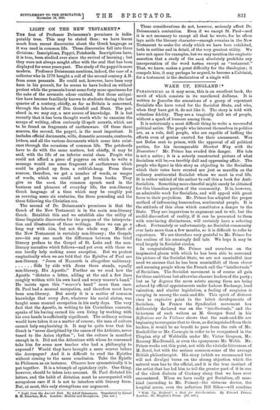LIGHT ON THE NEW TESTAMENT.*
Talc first of Professor Deissmann's premisses is indis- putably true. This may be stated thus : we have learnt much from recent discoveries about the Greek language as it was used in common life. These discoveries fall into three divisions : Inscriptions, Papyri, Potsherds. Inscriptions have, it is true, been studied ever since the revival of learning ; but they were not always sought after with the zeal that has been displayed for some years past. The study of the papyri is more modern. Professor Deissmann mentions, indeed, the case of a collector who in 1778 bought a roll of the second century A.D. from some peasants. He could not, however, have been very keen in his pursuit, for he seems to have looked on without protest while the peasants burnt some forty more specimens for the sake of the aromatic odour emitted. But these antiqui- ties have become familiarly known to students during the last quarter of a century, chiefly, as far as Britain is concerned, through the labours of Drs. Grenfell and Hunt. The pot- sherd is, we may say, a new source of knowledge. It is but recently that it has been thought worth while to examine the scraps of writing, often curiously ill-spelt scrawls, which are to be found on fragments of earthenware. Of these three sources, the second, the papyri, is the most important. It includes official documents, wills, domestic accounts, contracts, letters, and all the various documents which come into exist- ence through the occasions of common life. The potsherds have to do with the same matters, but chiefly, it may be said, with the life of an inferior social class. People who could not afford a piece of papyrus on which to write a message would use some fragment of earthenware which could be picked up from a rubbish-heap. From these sources, therefore, we get a number of words, or usages of words, which we could not get from books. They give us the xolvh, the common speech used in the business and pleasure of everyday life, the non-literary Greek language of a time which may be roughly put as covering some six centuries, the three preceding and the three following the Christian era.
The second of Dr. Deissmann's premisses is that the Greek of the New Testament is in the main non-literary Greek. Establish this and we establish also the utility of these linguistic discoveries for the purpose of the interpreta- tion and illustration of these writings. Here we can go a long way with him, but not the whole way. Much of the New Testament is certainly non-literary ; the Gospels are—let any one mark the difference between the brief literary preface to the Gospel of St. Luke and the non- literary narrative which follows—and yet even with these we can hardly help making some exception. But we protest emphatically when we are told that the Epistles of Paul are non-literary. " Jesus of Nazareth is altogether unliterary.
Side by side with Jesus there stands, equally non-literary, His Apostle." Further on we read how the Apostle "dictates a letter, adding at the end a few lines roughly written with his own hard and weary weaver's hand." He insists upon this " weaver's hand " more than once. St. Paul had a manual occupation, and therefore must have been non-literary. But surely it is a matter of common knowledge that every Jew, whatever his social status, was taught some manual occupation in his early days. The very fact that the Apostle, in writing to his Corinthian converts, speaks of his having earned his own living by working with his own hands is sufficiently significant. The ordinary artisan would have taken it as a matter of course ; the man of culture cannot help emphasising it. It may be quite true that his Greek is "never disciplined by the canon of the Atticists, never tuned to the Asian rhythm "; but the culture is manifest enough in it. Did not the Athenians with whom he conversed take him for some new teacher who had a philosophy to expound P Would they have brought a mere weaver before the Areopagus P And it is difficult to read the Epistles without coming to the same conclusion. Take the Epistle to Philemon as an instance. Observe how symmetrically it is put together. It is a triumph of epistolary style. One thing, however, should be taken into account. St. Paul dictated his letters, and the habit of dictation must be accompanied with scrupulous care if it is not to interfere with literary form. But, at most, this only strengthens our argument.
Light from the Ancient Bast. By. Adolf Deissmann. Translated by Lionel H. Strachan, M.A. London : Hodder and Stoughton. [16s. net.] These considerations do not, however, seriously affect Dr. Deissmann's contention. Even if we except St. Paul—and it is not necessary to except all that he wrote, for he often lays aside the literary character—enough remains in the New Testament to make the study which we have here exhibited, both in outline and in detail, of the very greatest utility. We have not space for examples, but we may mention the emphatic assertion that a study of the Komi absolutely prohibits any interpretation of the word becteipni except as " testament." That, we know, makes a great difficulty for the theologian ; it compels him, it may perhaps be argued, to become a Calvinist, for a testament is the declaration of a single will.


































































 Previous page
Previous page